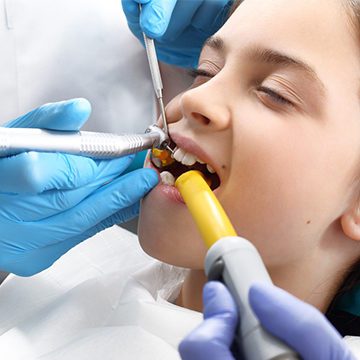
Sealants are typically placed on molars with deep pits and grooves. These molars are at higher risk for getting cavities because the anatomy of the grooves allows for bacteria and carbohydrates to get packed down into them. Sealing a tooth is analogous to caulking your bathtub, where the grooves are filled in with a hard, white material that leaves the tooth
feeling smooth. It is a relatively painless procedure and is recommended according to the anatomy of the tooth, oral hygiene of the child and potential risk factors the child may present at a particular dental examination

A prophylaxis involves removing superficial plaque, tarter and stain accumulated over a period of time. This is done by rotating a rubber-cup filled with an abrasive tooth paste against all exposed surfaces of tooth enamel. Tarter which is found below the gumline is removed by the dentist on examination. Kids get to choose what flavor they’d like for the cleaning, and believe it or not, they’re not too bad.

Flouride is a mineral used to strengthen enamel which has been weakened by acids sitting against the tooth. Acid, if left on enamel, slowly dissolves the tooth surface by pulling minerals off of the tooth. You may even think of it like the tooth getting microscopic potholes across it’s surface. Over time, this dissolving action can lead to the development of a cavity, or a giant sink-hole. Fluoride basically acts like a plug, filling in those potholes to help prevent the cavity from occurring. Most people are exposed to fluoride in their water, food, and toothpaste, but by itself, it is usually not enough. Our in-office fluoride application makes up for the difference.

X-rays are taken as a diagnostic tool. Cavities which form between the teeth can often only be seen when taking these films. X-rays can also help us determine your child’s risk potential for future cavities. Cavities which grow very quickly tell us your child likely has a combination of many cavity-producing bacteria with a carbohydrate-rich diet.
